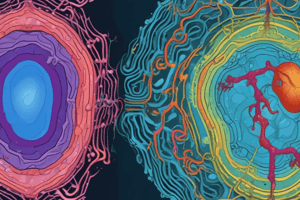Podcast
Questions and Answers
Which type of channel is always open and allows ions to pass through their concentration gradient?
Which type of channel is always open and allows ions to pass through their concentration gradient?
- Ligand-gated channels
- Leakage channels (correct)
- Gated channels
- Voltage-gated channels
In which type of transport does the substance move from a region of lower concentration to a region of higher concentration?
In which type of transport does the substance move from a region of lower concentration to a region of higher concentration?
- Facilitated diffusion
- Passive transport
- Active transport (correct)
- Simple diffusion
What is a key characteristic of selectively permeable membranes?
What is a key characteristic of selectively permeable membranes?
- They allow all substances to pass freely.
- They block all small molecules.
- They only allow ions to pass.
- They only permit specific substances to cross. (correct)
Which type of gated channel opens in response to a change in electrical charge?
Which type of gated channel opens in response to a change in electrical charge?
What is the primary distinction between passive and active transport mechanisms?
What is the primary distinction between passive and active transport mechanisms?
Flashcards
Gated Channels
Gated Channels
A membrane protein that allows ions to pass through a cell membrane, but only when a specific condition is met, such as a change in voltage or binding of a ligand.
Active Transport
Active Transport
A membrane protein that uses energy, usually in the form of ATP, to transport molecules across a cell membrane against their concentration gradient.
Concentration Gradient
Concentration Gradient
The difference in concentration of a substance between two areas, such as across a cell membrane. Substances naturally move from areas of high concentration to areas of low concentration.
Passive Transport
Passive Transport
Signup and view all the flashcards
Leakage Channels
Leakage Channels
Signup and view all the flashcards
Study Notes
Channels
- Leakage channels (passive channels) always allow ions to pass through their concentration gradient.
- Gated channels open under certain conditions:
- Ligand-gated: Receptor and channel are in one, hormones or neurotransmitters open them.
- Mechanically-gated: Open due to mechanical deformation of the membrane (e.g., blood pressure).
- Voltage-gated: Open due to a change in charge (e.g., neurons and muscle tissue).
Selectively Permeable Membranes
- Allow some substances to pass through while preventing others.
Transport Mechanisms
- Passive transport: Requires no ATP (e.g., filtration, diffusion, osmosis).
- Active transport: Uses ATP.
- Carrier-mediated transport: Uses membrane proteins to transport substances.
Concentration Gradients
- Difference in concentration of a substance across a membrane.
- Molecules naturally tend to move from high to low concentration.
Factors Affecting Membrane Permeability
- Size of molecule
- Properties of molecule (polar vs. nonpolar, charged vs uncharged, hydrophobic vs. hydrophilic)
Passive vs. Active Transport
- Passive transport: No energy used; moves substances down their concentration gradient.
- Active transport: Uses energy; moves substances up/against their concentration gradient; requires transport proteins.
Studying That Suits You
Use AI to generate personalized quizzes and flashcards to suit your learning preferences.



